With the two designs that I have created, I have decided to base them both on a similar layout however by changing the order of the movie listings through the use of various organisations and type weights, I was able to change the target demographic for each. For example I believe that the ‘Blue Listing’ appeals more to the “retired doctor and her husband, both of whom have a passion for old Hollywood” as the hierarchy emphasises the directors, time and place of the movies creation and the cast, where the ‘Pink Listing’ is more targeted towards “a father with two children under 10” as the times and age ratings are more prevalent.
Category: Student work
Autumn Film Festival
- Draft 1: traditional (for retired people with old Hollywood passion)
The first draft is design for retired people who have free time to watch film. By grouping films according to month and date, they won’t miss any filming date in schedule. Besides, retired people or someone who have passion for old Hollywood would extra focus on the context of the film, so I add a quote below each film name to attract these audience and priority their interest to the film. I also use a traditional and decorative font to the title of Reading Film Theatre and add text of High rated movies, so as to suit their characteristic and appeal my audience.
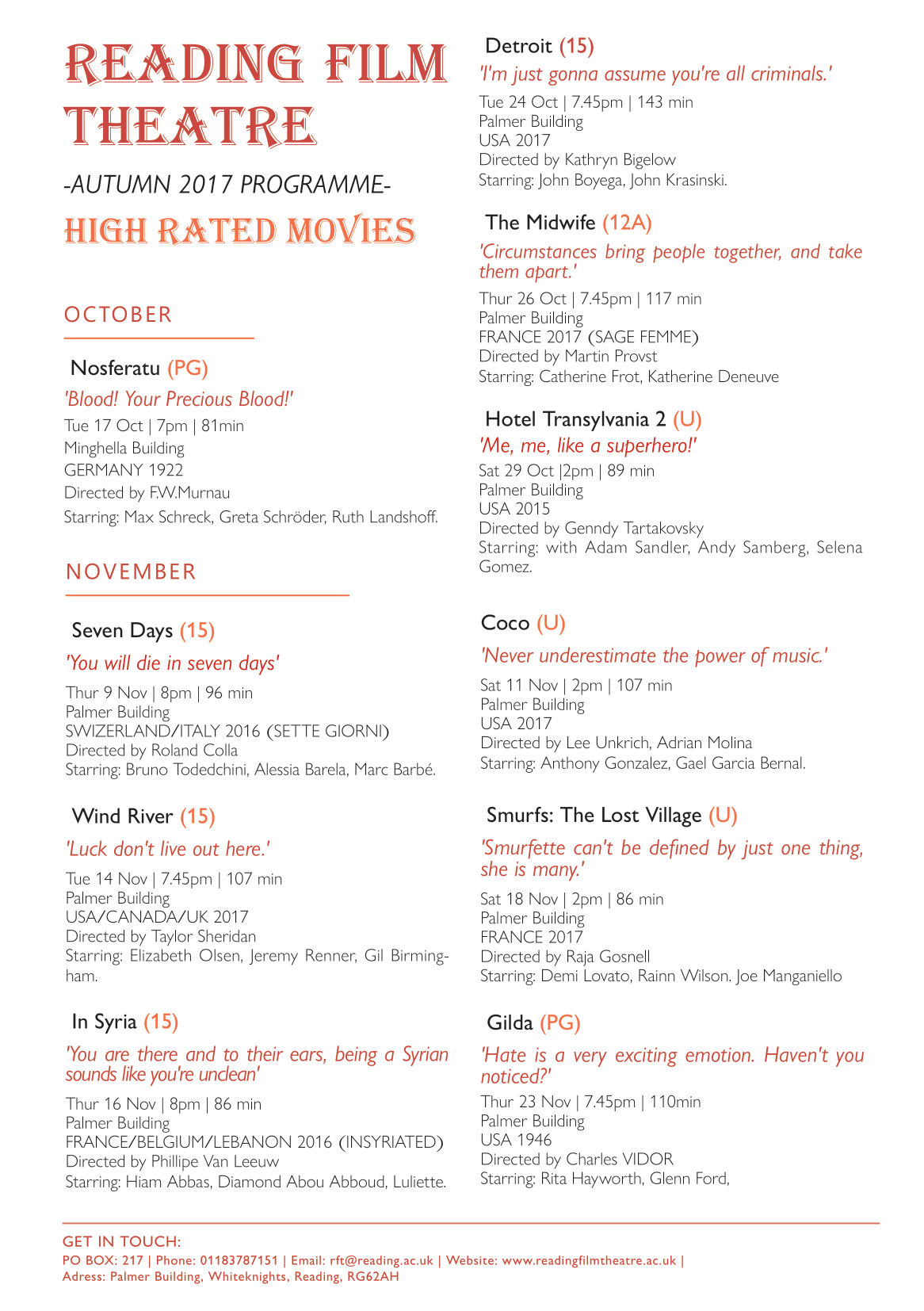
- Draft 2: mordernist (for international / busy people/ families)
The second draft is a more modernist design. As I would like to focus on the target audience of international and busy people, so I designed the flyer to be clearer and simplicity. Rather than grouping the movies by months, I distinguish them according to the film genre include classic, thriller and family friendly movie, which makes it easier to choose specific genre and relevant information for first prioritise, correspond with their own interests and to have a faster decision.
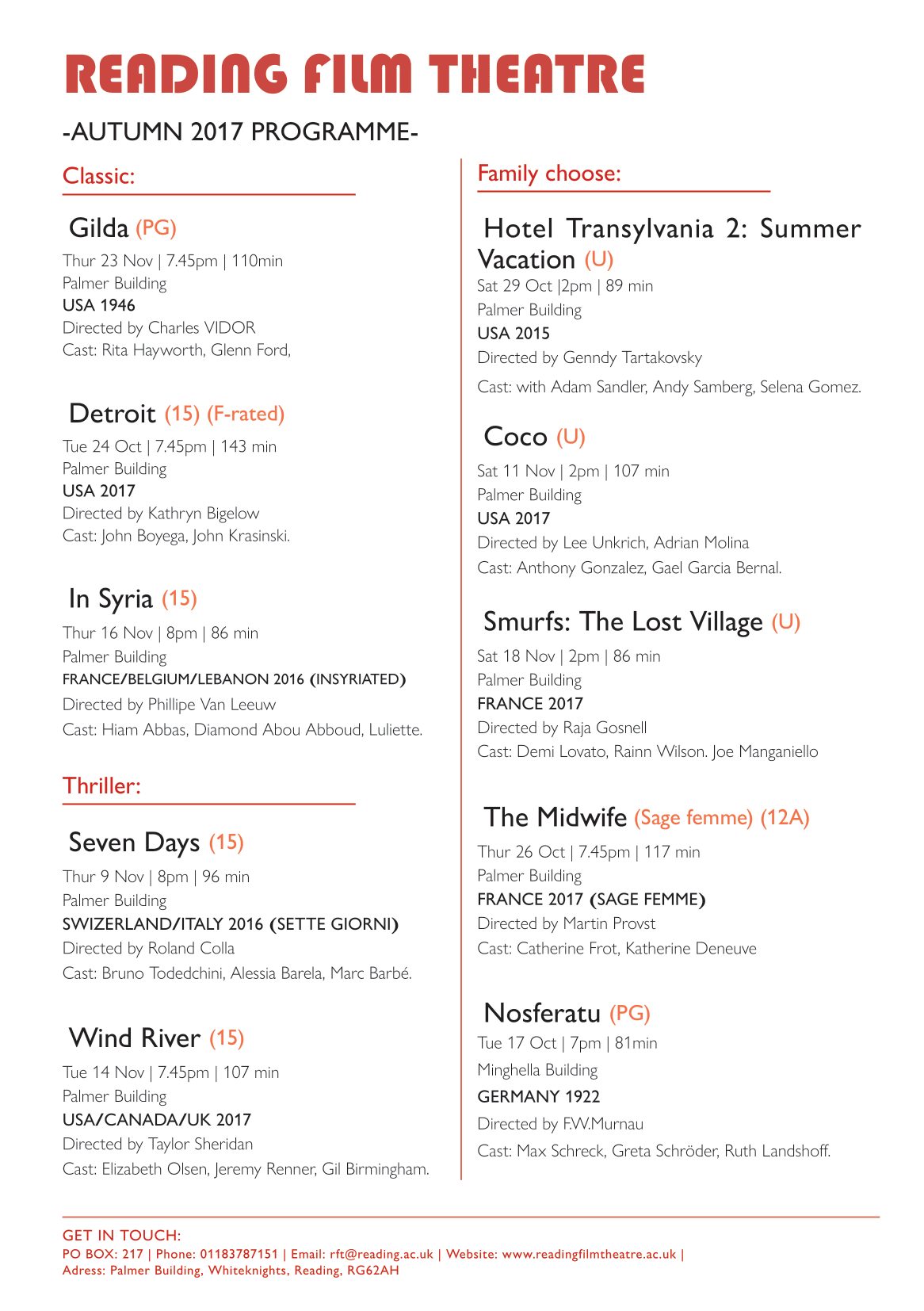
- Peers feedback
From the peer’s feedback, there are many typing and structure mistic that I can’t found by my own, such as wrong punctuation, type spacing, force line break to respect the cast, and repeated information found, which will be a serious mistake in real life situation, so I should be more aware on it for alternative designs.
Final decision
After adjusting the typing mistakes, I decided to combining the two designs above in mordernist way, as I reckon that it is better to benefit a wider range of target audiences, include retired people, families, internationals and people who have Hollywood passion,ect. I abandoned the month grouping version as the date is actually easily to find. I remain the film quote as to introduce the film little more and appeal different audiences.
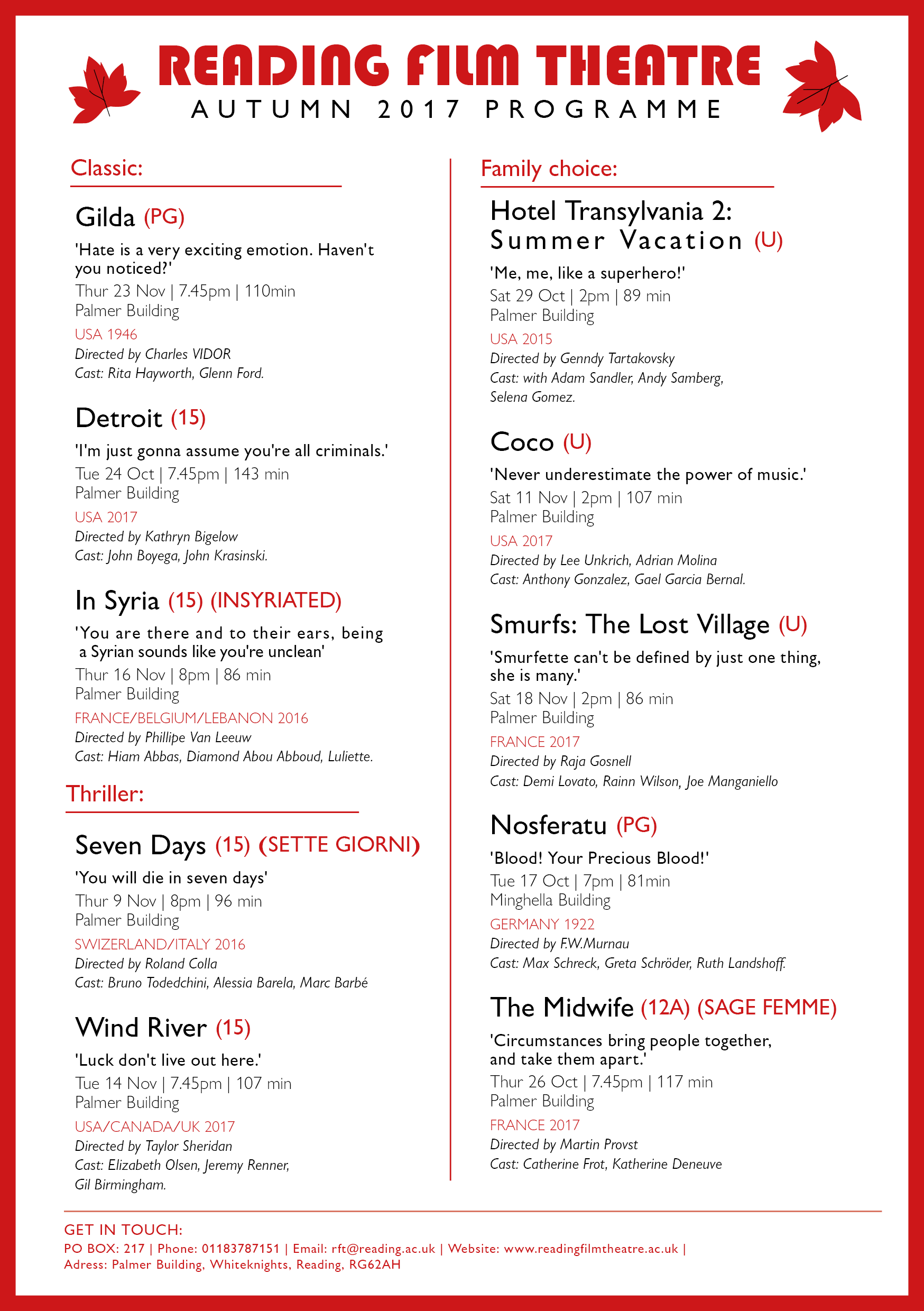
As to let my audiences choose what information they prioritize to look at, I haven’t particularly emphasis on a single title or information. However, I group the text by intrinsic and extrinsic information, as well as slightly change in font colour, weight and style to separate different information, so it will be easier to read. For example, I use red font in country which helpful for international user, bold text for the quote to have emphasize effect,ect. Lastly, modern font are used, also a red frame is added to create focus point to the information in middle.
By reflecting on my flyer design, I think I can improve in the informational grouping and idea of structuring the layout design in terms of hierarchy. It is a bit vague to read and boring for now, as it better to have featured layout style for an appealling first impression. I can look at peers work in achieving a more stylish flyer later.
B.O.A.C
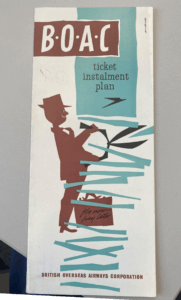
After initial research into this British Overseas Airway Corporation ticket installment plan brochure which dates back to 1960. The colours used throughout the brochure consist of brown, black and blue. There are san serif and serif fonts used throughout brochure with most of the more important information being bold and in a san serif font, making it more legible and obvious to the reader.
The brochure again hints at when it was dated through the use of predominantly male figures. The wording they use is also very ‘one gender dominant’ the last paragraph where it states ‘every man’. This clearly resembles a time similar to the 60s where women were seen as less than when compared to the man. This can also be seen in the images used where there is predominantly men.
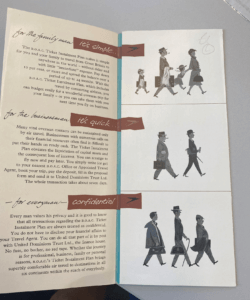
While the colour choice is quite unique, using brown, it does still work effectively. The use of colour does not take away or distract the reader, it does rather the opposite and compliments the brochure. Although the use of colour has been implemented correctly, there are still a few issues that I had when looking through this collection piece. I felt the way that they presented the pricings for the ticket installments could have been presented a lot better than how they were originally. After first looking at the brochure I was hit with instant confusion, the way that the numbers have been presented.
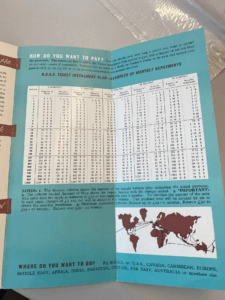
1870s Vintage Sheet Music
Background information
The collection I chosen was a sheet music cover from Frank Laughlin: The Orphan, illustrated by T. W. Lee, and published by Chappell & Co Ltd (New Bond Street, 50 – London) in 1870.
Illustration: Cat and sheet music in 19th century
The reason I choose this sheet music is that I was appeal by the drawing of the kitten, which is realistic and cute. From the picture, we can see a woman that put on noble clothes and accessory was holding a wretched and little kitten by whole hand, which correspond with the title ‘The Orphan’ above. The picture creates a sense of sadness and helpless of the kitten, which I assume the target audience may be upper class woman, and the illustration arouse their sympathy and appeal them to listen the music. Besides, the text is in different typography style, which is decorative.
In 19th century’s sheet music cover, there are quite a lot illustrations found using cat as object. It is said that animals were often used in advertising caught on in Victorian times, as using anthropomorphized animals in human activities more clearly demonstrates to the viewer an aspect of the character’s personality, thereby making the consumer more sympathetic with the animal in question.
Printing technique: Lithographic
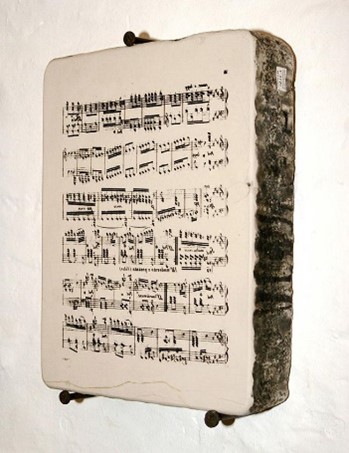
(An example of lithographic stone for printing music. The music is written backwards on the stone.)
Lithography is invented by Alois Senefelder in 1796, and was first used to print music in 1796 and the earliest music sheets to be illustrated by lithography were produced in this country in about 1820 and were coloured by hand.
According to the video on lithographic process and website of music printing history, the process involved drawing an image or text on a smooth piece of limestone with an oil-based ink. Then, acid was poured onto the stone to burn the image onto the surface. A water soluble solution was then applied, sticking only to the non-oily surface and sealing it. For printing, the water adhered to the gum arabic. The oily ink, however, repelled the water, thereby allowing for the printing of the images.
Overall, I have learnt the complicated printing process in lithography, the asthetic of vintage 19th century sheet music, and how illustrator attract the audience by animals in sheet music cover and advertisment. These advance me a lot in the history of printing and future album covers design.
Joyful Theatre
I started this project with some experimentations in indesign. I did some trials in the margins and columns as I tried to do landscape mode with 2 rows to fit the paper. I learned how to do the table in indesign so I could arrange the text equally along the page. I began my search on past cinema listings and was inspired by many of them. I noticed how each listing has a different type of font that made the audience feel like they’re in the cinema. Then, I searched for fonts on google that fit well the movies theme and chose “Joyful Theatre” as my main font. I wanted a color that could be strong and independent above the white background so I chose black and dark blue. I tried playing around with the tint in some places too. Next, I added as many paragraph styles as I can in order to practice using them when there are many texts. I aligned the texts together and added a ruler guide for each line so every text would be aligned perfectly. I used Gill Sans Nova font to state the movie’s description, location, and date. I added paragraph rules below the movie title in order to align the date and location of the movie in a designed way. I tried to make the list easy for the eye to read so every age can be attracted to it. I believe I can use many of these stuff I learned in the book design project, especially the paragraph styles and ruler guides.
The Ritz Menu
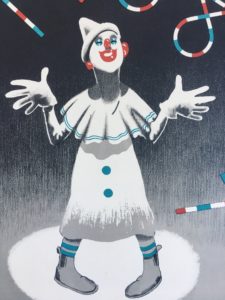 For this mini brief I’ve chosen to write about a menu for New Year’s Eve 1937 at The Ritz. This particular item grabbed my attention with its print design’s minimalist use of colour, and hints of Art Deco style. The gradient in the background shifts the viewer’s focus to the face of the clown and the type by giving the upper half of the design higher contrast between dark and light. The arch in the ‘1938’ frames the clown nicely and draws together the focal points of the image further. The design successfully conveys the theme of celebration which is appropriate for the occasion.
For this mini brief I’ve chosen to write about a menu for New Year’s Eve 1937 at The Ritz. This particular item grabbed my attention with its print design’s minimalist use of colour, and hints of Art Deco style. The gradient in the background shifts the viewer’s focus to the face of the clown and the type by giving the upper half of the design higher contrast between dark and light. The arch in the ‘1938’ frames the clown nicely and draws together the focal points of the image further. The design successfully conveys the theme of celebration which is appropriate for the occasion.
The fun outside cover of the menu is juxtaposed, on the inside, by a formal choice of typeface which matches the prestigious image of The Ritz Hotel. Rules are then used to break up the separate dishes on the menu — this is especially helpful seeing as the highly embellished ascenders tend to slightly obscure the lines. The layout is very simplistic and the items on the menu are ordered in a way that gives the body of text a diamond shape which is an elegant stylistic touch.
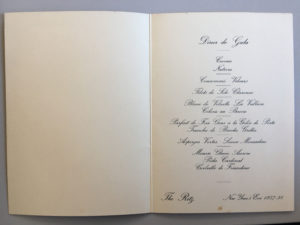
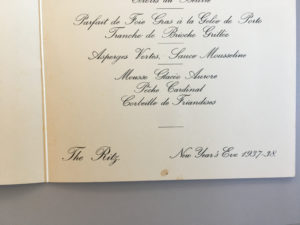
Cinema Listings Development
The Reading Film Theatre brief involved having to produce a pamphlet for the Reading Film Theatre Autumn 2017 Programme, presenting 10 films along with information about them on the page. It had to only include 2 colours (white does not count as a colour in this circumstance), 2 fonts, and possess 2 columns to present the information. Additionally, our design had to cater to a particular audience, such as a parent with 2 children and an elderly couple.
For my first draft, I included a gold gradient background along with black text to present the information. My initial ideas were to reference the “golden age” of Hollywood cinema, like the 1950s an 1960s; leading to me adding the gold background. My design was supposed to appeal to the older audiences, or connotate that it was of a classic cinema style, but I had not realised that I had already failed one of the briefs of having only 2 colours. Also, due to the text being the same colour and similar point size, it was fairly complicated to read upon first glance. Furthermore, my inclusion of paragraph rules were not very helpful as they were the same colour as the text. Cinema Listing 1
With my second design I decided to only include a light blue colour and black text as I did not want my design to be as needlessly complicated to look at. However, in light of focusing on minimising my design I had forgotten about my chosen audience, which resulted with me becoming confused on what to do next. This, along with my lack of current Adobe InDesign knowledge, made me want to learn about how I could improve my design by seeking feedback from the Friday lesson. Cinema Listing 2
After, the feedback lesson I decided to simplify my design as well as not overcomplicate the visuals, along with editing general mistakes such as errors within the text. I decided to focus on the colours of the University logo that is usually depicted as red and white, to fit the colour scheme. The pdf file does not allow the font that I had chosen for the title, but for reference I had initially used a font called “Showtime”. This font had a Hollywood inspired text along with old film tape acting as borders above and below the title. I wanted my design to focus on being intended for the use of the elderly, as it was a simple design that became easier to read compared to my last concepts. The minimal use of red for the title as well as the titles for the films enhances the importance of the films and associates with the hierarchy of information, conveyed in Lonsdale and Twyman’s journals of typography. RFT Actual Design
Real mermaid
This was a news notice that I had found within the collections. This particularly stood out to me because someone had written on it in the top right corner. To me this made the piece much more personal and unique. I loved the look of the handwriting and how there was a slight bleed in the ink, giving it a more historical feel. The notice declares that a “mermaid” was caught alive on the coast of the Shetland Islands. However, the writer of the notice conveniently didn’t include an image of the mermaid to prove his claims. I think that was intentional to entice more people to pay and see the exhibition.
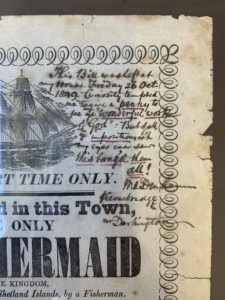 Mr Darlington’s note (in the top right corner) was very hard to decipher. I couldn’t figure out if he was amazed by the exhibition or if he was disappointed. To me, the description of the mermaid sounds a lot like a large fish with hair, I can’t say I was surprised, but I’m sure that this must of been news to spread around town. I think everyone would have their own opinions about whether it was true or not, even today.
Mr Darlington’s note (in the top right corner) was very hard to decipher. I couldn’t figure out if he was amazed by the exhibition or if he was disappointed. To me, the description of the mermaid sounds a lot like a large fish with hair, I can’t say I was surprised, but I’m sure that this must of been news to spread around town. I think everyone would have their own opinions about whether it was true or not, even today.
RFT Listings
Reading Film Theatre Listings
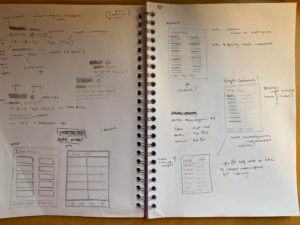
I started off this project by drawing up small sketches of my initial layout ideas, I’d quickly decided that I’d have the main heading left aligned at the top of the page and then the contact info at the bottom, deciding this early meant that I then had a determined space for my actual content of the page, this allowed me to appropriately size the rest of the page properly.
I’d also focused on my layout for specifically each block of information, my idea was to keep this page with as few rules and lines and boxes as possible to allow it to read easy and feel breathable almost, this meant my layout for the information had to be clear and consistent between each section.
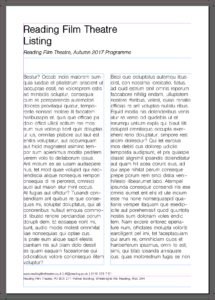
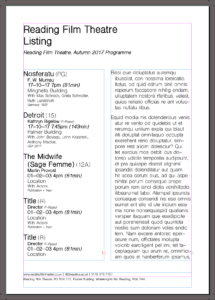
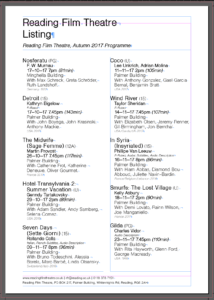
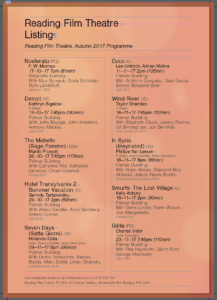
I started by creating the general layout and the columns, then created a template for the format i’d decided on for the information. I found doing it this way that as i went along and input all of the information i was able to adjust the sizing appropriately when i input new information and i learnt what the spacing and sizing actually needed to be as i went along. My main focus was to keep a systematic format for each section so that once you’d read one section of information you’d be able to understand all of them, this proved awkward in areas such as “Hotel Transylvania 2” where the name was extra long and required 2 lines, this led to me deciding to use an ‘outdent’ for the main title of the film, further separating the sections but meaning that names that spanned over 2 lines were still just as readable as any other while not taking up an obnoxious amount of space horizontally on the page.
Another of my steps was creating a background, since my goal was to create a format of bolds/italics/sizes/lines to break up the information in a block into understandable sections this meant that my choice of colours was free to use for the background graphic, using a mesh gradient i created a purple and orange background which wouldn’t be overpowering to look at but gave it a friendly feeling still rather than a blocky full colour background, next for this i decided to add in lighter sections of blurred circles attempting to tie into the theme of cinemas with a pseudo lens flare effect on the background. I created this is illustrator and then placed it into the indesign document.
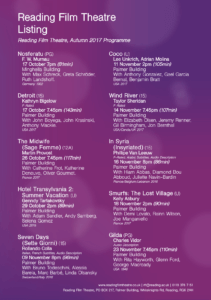
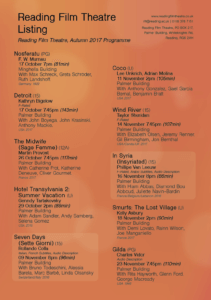
Techniques learnt from Indesign
Reading film theatre (red and black-final)
Shown here is my cinema listing I created on Indesign. I chose to use this specific title as it reflects on my learning from this task. The reason it reflects so well is because from creating my two listings (one is showed here) I learnt new things and enhanced my knowledge on some of the techniques.
Before doing this task I struggled with using paragraph styles and characters and now I feel a lot more confident with using them for future tasks/projects. When I did stuggle to create some things or find some things I used the internet and researched how to overcome the issue.
Some issues I did overcome while creating my two listings were having to stop forcing line breaks, instead i used paragraph styles to help me. Overall I feel I have learnt a lot from this, one being to ask for feedback to improve my work and ideas as the feedback I recieved helped me to make my final outcome better.
